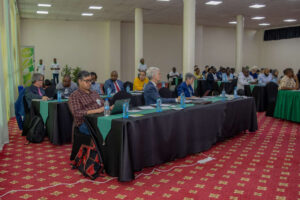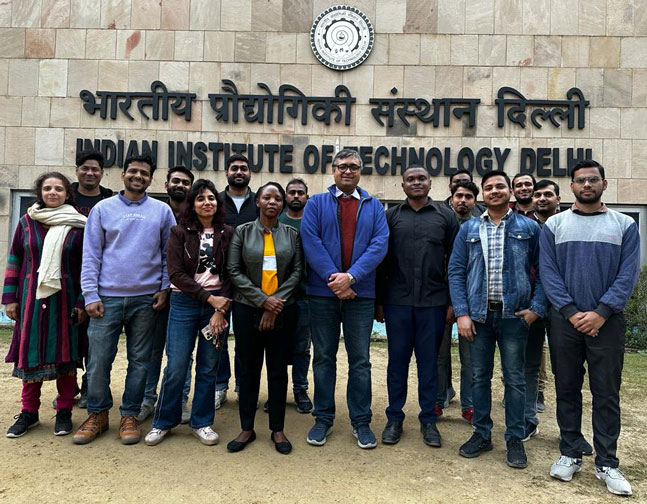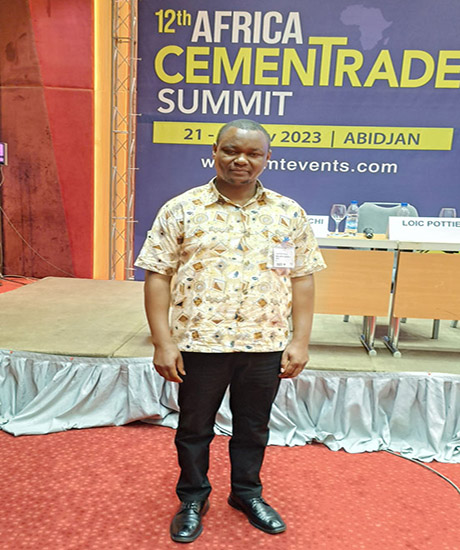LC3-TRC Africa Scene-Setting Presentation at the UN Climate Change in Bonn, Germany

The Limestone Calcined Clay Cement-Technical Recourse Center Africa (LC3-TRC Africa) is going global in advocating for greenhouse gas emission reduction in the built environment!
The Head of the LC3-TRC Africa, Dr. Joseph Mwiti Marangu, had the privilege to make a scene-setting presentation at the recently concluded UN Climate Change in Bonn, Germany, held between 27th and 29th May 2024. As echoed by the LC3-TRC Africa, his message is the need for Greenhouse Gases (GHG) reduction interventions with the attributes of “SPEED AND SCALE.” Adopting LC3 is a crucial strategy in attaining reduced carbon emissions that align with the attributes.
The event aimed to lower carbon emissions in the built environment by reducing operational and embodied carbon emitted in the building industry. Presentations by various guests who are notable in the built environment tackled topics ranging from reducing operational operations, carbon efficiency through the design of building envelopes, taking stock of embodied carbon, and progress on green cement and concrete to cater for embodied emissions.
Dr. Joseph Mwiti’s (Head of LC3-TRC Africa) message was on the need to consider “SPEED AND SCALE” in curbing emissions with a specific focus on building materials. He highlighted the need to ensure that the two aspects are considered to ensure that tangible and lasting results in the global south are achieved when lowering GHG emissions in the built environment.
In his presentation, he highlighted that currently, the built environment contributes approximately 42% of all global carbon emissions. The emissions occur in two distinct ways: embodied and operational carbon emissions. Embodied emissions refer to those that are produced during the production of the building, and they are primarily from materials and construction activities, while operational emissions are those associated with building operations such as lighting, ventilation, and heating.
Currently, about 75% of these emissions in the built environment are attributed to operations, while 25% is attributed to embodied carbon. However, this is set to change by 2050 as about 75% of all projected infrastructure in 2050 are expected to be built in the next three decades and are expected to be built in developing countries, which are predominantly in the Global South. Therefore, in 2050, carbon emissions from embodied and operational emissions will contribute almost equal parts, at 49% and 51%, respectively.
Due to the expected surge in construction in the Global South, about 90% of the cement demand will come from this region, particularly India and Africa. In line with this realization, decarbonizing cement and associated materials is necessary to ensure that India and Africa do not become victims of increased GHG emissions like China has in the last two decades.
To curb the expected surge in carbon emissions within the next three decades, Africa, India, and the rest of the Global South must put carbon emission measures that resonate with the mantra of SPEED AND SCALE.
He indicated that accelerating the uptake of Limestone Calcined Cement (LC3), a low-carbon cement, is one of the scalable interventions that will meet the UN climate change dialogue’s objectives regarding greenhouse gas emissions. LC3 uses widely available a Supplementary Cementitious Materials (SCMs) – calcined clay and limestone- which is widely available in the Global South. LC3 is a blended cement that reduces CO2 emissions in cement by 40%. It is projected that adopting LC3 can save up to 500 million tons of emitted CO2 by 2030. Currently, this low-carbon cement is produced by 9 cement plants, and the number is expected to be more than 20 by 2025.
Approaches that lowers clinker content in cement through the use of SCMs, using less cement in concrete and less concrete in construction through optimizing building design is pivotal in GHG emission reduction. Promoting the circular economy in building is also pivotal. These approaches can reduce emissions by 70%-80%, even without revising codes and standards or using Carbon Capture and Storage.
Dr. Mwiti also highlighted some challenges that may hinder attaining these GHG emission reductions and emphasized the need to undertake comprehensive risk assessment and mitigation. Low public awareness, low government support, minimal policy support, fragmentation of the building industry, and the lack of green procurement and financing incentives hinder the efforts to decarbonize buildings.
The head of LC3-TRC Africa had a chance to network, interact, and share insightful ideas with stakeholders in the energy, building, environment, green building, and policy advocacy sectors.
The end of the dialogue marked a highlight for the LC3-TRC Africa in advocating globally and, more importantly, the start of a new journey in pushing for scalable and fast contributions in decarbonizing the building industry. LC3-TRC Africa reiterated its commitment to lower carbon emissions in Sub-Saharan Africa and the global south.
See the link below for more details: https://unfccc.int/event/third-global-dialogue-and-investment-focused-event-under-the-sharm-el-sheikh-mitigation-ambition-and








